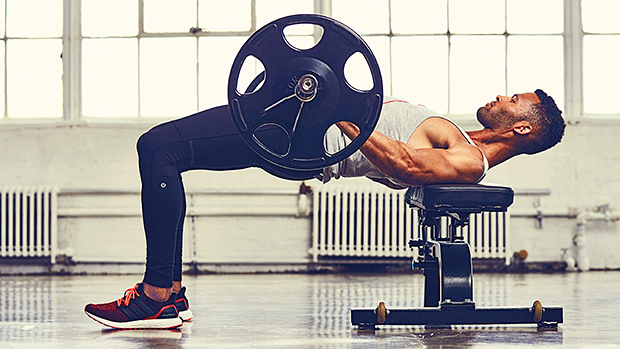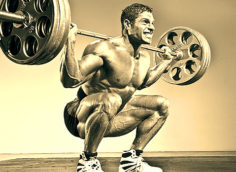Kettlebells: Better Than Dumbbells
Kettlebells are a highly effective training tool for triceps growth. The key is knowing how kettlebells can be applied to make certain movements even more effective than their traditional counterparts. Here are six kettlebell exercises that'll leave your triceps screaming.
Many bodybuilders believe that the decline skull crusher is superior to the flat bench variation. The decline produces the greatest range of motion and provides high levels of stretch that optimize muscle hypertrophy. But most triceps exercises done with free weights involve little tension in the contracted (top) position.
Not so with the kettlebell skull crusher. Kettlebells provide constant tension because of the angle of pull. This produces greater occlusion, triggering metabolic stress, cellular volumization, and overall muscle pump, all of which are key mechanisms for growth. The decline kettlebell skull crusher also hits all three heads of the triceps.
The decline reduces involvement of the shoulders, forcing the brunt of the work on the triceps. Many lifters also find the decline position to be easier on the elbow joint.
To do these, lie on a decline bench angled at 15-20 degrees and perform a standard skull crusher by pivoting at the elbow joint and lowering the weight to the sides of the forehead. Pause at the bottom, then forcefully drive the kettlebells back to the top, stopping just shy of lockout. Repeat for several sets of 6-8 reps.
This is actually called the "eccentric-accentuated compound-isolation incline kettlebell skull crusher." But that would make me sound ridiculous. The name is a mouthful, but once you analyze each component you'll see why it's so effective.
It's a "compound-isolation" exercise in that the eccentric or negative involves an isolation movement in the form of a skull crusher, while the concentric (lifting part) involves a compound movement in the form of an incline press. This allows you to use supramaximal loads (greater than your 1RM) on the negative part of the movement and still be able to lift the weights back up.
This causes incredible stress and micro-trauma, an important mechanism of muscle growth. You'll be handling approximately 120% of your max load during the skull crusher, but roughly half that for the incline press.
Although this same compound-isolation protocol can be done in flat or decline positions, the incline allows the greatest relative workload (percentage of your 1RM) during the concentric pressing phase. The pressing phase becomes a semi-rest period that serves as a means of re-setting for the next heavy eccentric skull crusher.
The pressing phase also involves more activation of the lateral and medial head while the skull crusher mainly targets the long head. As a result, you'll trigger size and strength gains throughout the entire triceps region. Just be prepared to have incredibly sore tri's for several days.
To do it, lie on an incline bench set to 25-40 degrees. Using heavy kettlebells, perform a negative skull crusher by pivoting at the elbow and lowering the weight slowly to the sides of your head. Once you reach the bottom, pull the kettlebells toward your chest and do a standard incline chest press. Repeat for three sets of 5-6 reps.
To increase the intensity, once your triceps fail and you can no longer control the skull crusher phase of the movement, try doing an additional 5-6 strict incline presses. Your triceps will be pre-exhausted so they'll give out well before any other muscles, which makes this highly effective for stimulating size gains.
Overhead triceps extensions are an old-school exercise that bodybuilders have been doing for years. It typically isolates the long head of the triceps. But the kettlebell variation hits all three heads including the lateral and medial heads. As a bonus, you'll create more constant tension.
In addition, holding kettlebells overhead involves a significant degree of instability, forcing you to use a more controlled lifting tempo and stricter mechanics.
To make it even more effective, do these while kneeling on a bench. This requires even greater muscle activation and stability. Any cheating, shifting, or compensation patterns will cause you to lose balance, providing immediate feedback and ensuring better form.
Just grab light to medium-weight kettlebells, kneel on a bench, and then raise the dumbbells overhead. While keeping the shoulders locked into position, lower the weight behind your head. The elbows can flare out slightly. Keeping them too straight can place too much stress on the joints. Do 2-3 sets of 8-10 reps while pausing at both the top and bottom.
This constant-tension exercise is one of the most difficult triceps mass builders there is. Simply lie on either a bench or the floor and do skull crushers in an alternate fashion with kettlebells. However, there's a catch. In between reps, the arm that's not moving is held at the bottom of the skull crusher, just above head height.
This position, along with the constant pulling tension created from the kettlebells, creates enormous levels of mechanical tension, metabolic stress, and muscle damage, making this one of the greatest mass-builders you'll ever use for triceps.
If you're looking to notch things up another level, try doing them with the lower body elevated in an isometric leg raise position throughout. This increased tension throughout the lower body and core produces a neurophysiological phenomenon known as concurrent activation potentiation (CAP).
That means greater neural drive to the rest of the extremities including increased motor unit recruitment and innervation throughout the triceps. Do just 4-6 reps per arm for strength and size gains.
Dumbbell kickbacks kinda suck – there's tension only in the top contracted position. Using cables or bands to create tension throughout the entire range of motion is more effective, but not as effective as kettlebells.
Because of their unique leverage and loading mechanics, kettlebells place a huge amount of strain on the triceps, particularly on the lateral and medial heads. Although they won't give you as much continuous tension as the cable variations, the amount of activation in the contracted position is so great that it more than makes up for the momentary relaxation in the stretched position.
The key is to use a somewhat compact range of motion. Rather than extending too far, which causes the rear delts and lats to take over, try pausing in the contracted position where the arms are approximately in line or slightly below the plane of the torso.
Multiple sets of higher reps (12-20) are ideal for this unique triceps blaster.
The two most common skull crusher mistakes are allowing the elbows to flare and collapsing in the stretched position. The bottoms-up skull crusher with kettlebells fixes them both.
The instability produced from the bottoms-up position forces the shoulders to retract and depress throughout, which reinforces the all-important elbow tuck. And the unique leverage makes it nearly impossible to collapse at the bottom. Rather than allowing the triceps to relax and allow excessive range of motion, the bottoms-up skull crusher promotes optimal body mechanics and ideal joint angles.
You'll be forced to terminate the end range of motion where the arms are about parallel to the floor with 90-degree joint angles at the elbow. If not, the kettlebells will literally come crashing down onto the head and shoulders. And that's not fun.
Besides instilling strong biomechanics, this exercise places the greatest amount of stress on the triceps due to the optimization of the length-tension relationship within the muscle fibers themselves.
Finally, because of the longer lever-arm produced from the bottoms-up position, the amount of tension, particularly in the stretched position, is unusually high. That's why you should perform these in an eccentric isometric fashion where you do a slow negative, followed by a long pause in the stretched position. This maximizes the sweet spot of the exercise.
Even with relatively lighter loads, these tend to cause rapid fatigue. With this in mind, sets of 6-10 reps will do the trick.




